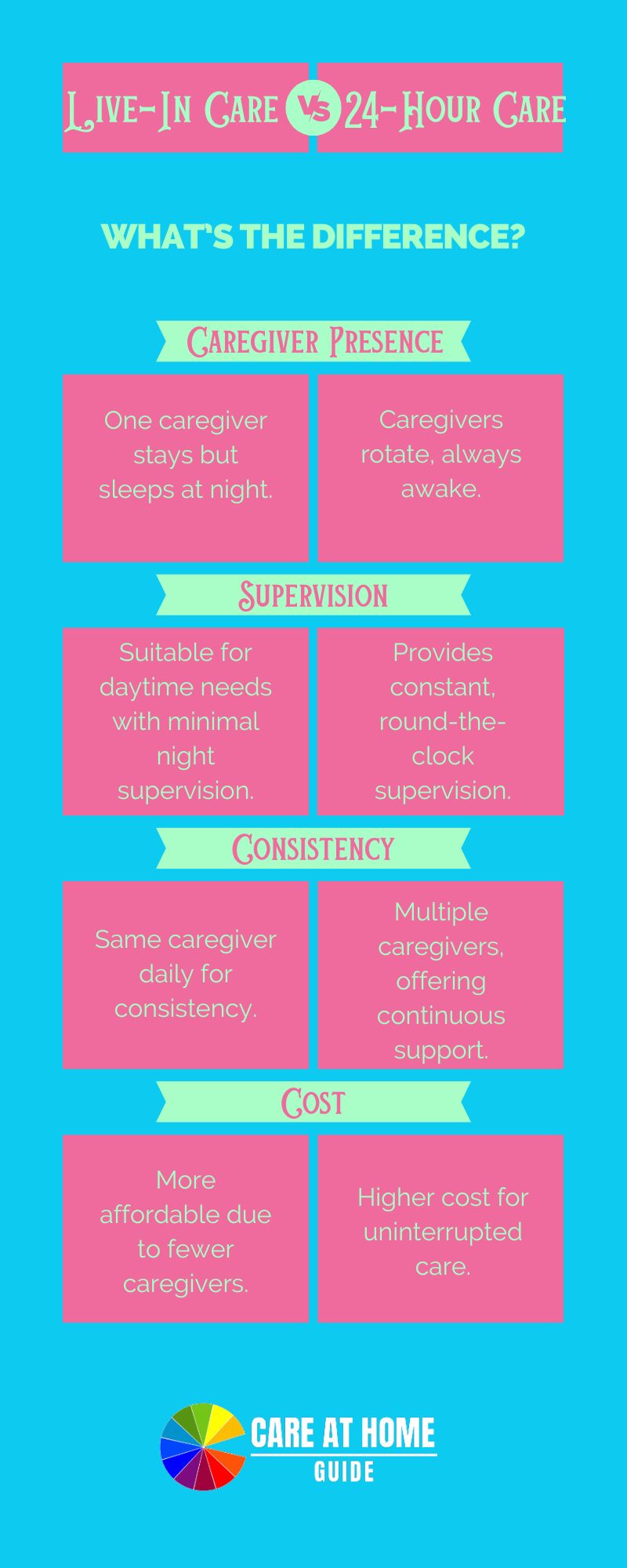
Understanding the Difference Between Live-In Care and 24-Hour In-Home Care

Which is Right for Your Loved One?
When it comes to in-home care for an aging or chronically ill loved one, two primary options often emerge: live-in care and 24-hour care. While both offer professional support and assistance within the comfort of home, the services differ significantly in terms of coverage, caregiver responsibilities, and cost. Making the right choice between these options can have a profound impact on the well-being of your loved one and the overall quality of care they receive.
In this blog, we will explore the distinctions between live-in care and 24-hour in-home care, breaking down their benefits, challenges, and suitability for different care needs.
What is Live-In Care?
Live-in care involves a single caregiver who stays in the home with your loved one for an extended period, often for days at a time. This caregiver is available during the day to assist with personal care, household tasks, companionship, and medication management, among other duties. However, one key aspect of live-in care is that the caregiver requires a designated rest period, usually 4-8 hours of sleep at night.
Live-in caregivers generally work 5-7 days in a row before rotating with another caregiver. They are on-call to help during the night but may not provide constant supervision during sleep hours. The caregiver typically lives with the client, forming a closer relationship over time, which many families find comforting.
Benefits of Live-In Care
- Cost-Effective: One of the main advantages of live-in care is its affordability. Since only one caregiver is needed for an extended period, the overall cost is lower compared to 24-hour care.
- Familiarity: Having the same caregiver on a continuous basis fosters a deeper sense of trust and rapport between the caregiver and the client. This consistency can be particularly important for those with conditions like dementia, where routine and familiarity are essential.
- Flexibility: Live-in care is ideal for individuals who may not require constant attention but benefit from daytime assistance with activities such as bathing, dressing, meal preparation, and light household chores.
Challenges of Live-In Care
- Limited Overnight Coverage: Since the caregiver requires sleep, live-in care is not suitable for individuals who need round-the-clock supervision, especially if they wake frequently at night.
- Privacy Considerations: Having a caregiver living in the home can be an adjustment for both the client and the family, particularly if privacy is a concern.
- Physical Space: The caregiver will need a designated sleeping area within the home, which may not be practical in smaller living spaces.
What is 24-Hour Care?
Unlike live-in care, 24-hour home care ensures that your loved one is never without assistance. Caregivers work in shifts—typically 8 or 12 hours—to provide constant, awake supervision at all times. This option is ideal for individuals who need ongoing care, including those with advanced medical conditions, mobility issues, or cognitive impairments like Alzheimer’s or dementia.
Since caregivers rotate through shifts, there is no downtime, and someone is always available to assist with both daytime activities and nighttime needs, ensuring full-time attention and security.
Benefits of 24-Hour Care
- Continuous Supervision: The most significant benefit of 24-hour home care services is that your loved one will never be left unattended. This is particularly important for individuals at risk of falls, wandering, or medical emergencies.
- Overnight Assistance: For those who wake frequently, experience night terrors, or require assistance with late-night medications or bathroom visits, 24-hour care provides the reassurance that help is always available.
- High-Level Support: This type of care is best suited for individuals with complex health needs, such as those recovering from surgery, living with chronic conditions, or requiring advanced palliative care. The constant availability of caregivers helps manage unpredictable medical conditions more effectively.
Challenges of 24-Hour Care
- Higher Cost: Since 24-hour care requires multiple caregivers working in shifts, it is generally more expensive than live-in care. This can be a financial burden for families, especially if long-term care is needed.
- Multiple Caregivers: With rotating shifts, there is less consistency in care. While caregivers will be trained and qualified, it may take time for the client to adjust to different faces.
- Logistical Management: Depending on the care agency, managing multiple caregivers and ensuring seamless transitions between shifts may require more coordination and oversight.
How to Choose Between Live-In Care and 24-Hour Care
Deciding between live-in care and 24-hour care ultimately depends on the needs of your loved one and your family’s resources. Here are several factors to consider:
- Level of Care Required: Does your loved one need assistance around the clock, or do they primarily need help during the day? For individuals with more predictable care needs and the ability to sleep through the night, live-in care may be sufficient. However, if your loved one requires frequent monitoring or assistance at all hours, 24-hour care is the better choice.
- Budget: Cost is a critical factor in the decision-making process. Live-in care is generally more affordable than 24-hour care, but it may not offer the same level of supervision. It’s important to balance the financial impact with the quality of care needed.
- Personal Preferences: Some individuals feel more comfortable with the same caregiver over an extended period, while others may appreciate the energy and fresh perspectives that come with rotating caregivers. Understanding your loved one’s preferences will help guide your decision.
- Medical Needs: Those with advanced medical conditions, especially individuals who are bedridden or have severe cognitive impairments, may require the constant supervision and quick response times that only 24-hour care can provide.
- Living Space: If your home does not have enough space to accommodate a live-in caregiver, 24-hour care may be a more practical option, as caregivers working in shifts do not require personal living quarters.
Closing Thoughts: Choosing the Best Care Option for Your Loved One
Both live-in care and 24-hour care offer unique advantages depending on the situation. Live-in care is an excellent option for those who require consistent daytime support with minimal overnight supervision, while 24-hour care is ideal for individuals who need continuous attention and advanced care.
As you navigate the decision-making process, consider your loved one’s specific needs, preferences, and the level of care required to ensure they remain safe, comfortable, and well-supported in their home environment.
Resources:
- What is the Difference Between Live-in Care and 24 Hour Home Care – Nurse Next Door
- What is the Difference Between Live-in Care and 24-Hour Care? – The Key
- Live-in Care vs 24-Hour Home Care – Assisting Hands
